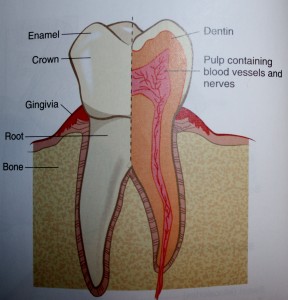Another important role of the mouth in food digestion is the mechanical action of teeth. In contrast to bone, neither the tooth enamel nor dentin can be repaired or replaced by any natural process other than simple remineralization of small areas and deposition of secondary dentin around the pulp chamber. Mineral deposition and resorption influence the supporting bone structure. Alveolar bone is primarily trabecular bone (bony spikes forming a meshwork of spaces in cancellous bone) and cancellous bone (internal bone that appears spongy with little hollows that contain bone marrow). When negative calcium balance occurs, the alveolar process (crest of the maxilla and mandible serving as the bony investment for the teeth) is more susceptible to resorption than other cortical bones (compact external part of the skeleton that surrounds the bone marrow). The maxilla and mandible to some extent depend on the presence of teeth and occlusal forces associated with chewing to prevent calcium resorption. Chewing firm foods helps maintain proper balance between alveolar bone resorption and new bone formation. Teeth and supporting bone structures are affected by intake of adequate nutrients, adequate digestive function, and hormonal balance.
Chewing reduces food particle size. Inability to masticate food adequately may result in larger chunks of food being swallowed. Larger pieces of food increase the potential for food obstruction in the airway. Food asphyxiation, which may result in sudden death, occurs in many individuals with defective, incomplete, or poorly fitting dentures. The loss of even one permanent molar may decreasemasticatory efficiency, or how well the patient prepares the food for swallowing. Even after patient become fully adjusted to well-fitted dentures, masticatory efficiency is reduced compared with patients with their natural teeth.
Digestion of food is facilitated by increasing its surface area. Whether or not particle size affects its digestibility is uncertain. However, when elderly patients have digestive problems, masticatory efficiency is usually a factor. Frequently, when masticatory efficiency declines, people choose foods that require less chewing or use techniques to soften foods, such as stewing meats, steaming vegetables, or dunking cookies or toast in fluids. In many circumstances, hypersensitive, poorly restored, decayed, abscessed, or periodontally involved teeth affect food choices and limit the variety of foods consumed.
Nutritional Directions
- Natural teeth are more efficient for chewing and biting than any prosthesis.
- Tooth losses are not inevitable; most people can maintain their natural dentition throughout life if preventive dental measures are practiced routinely.
- If salivary flow is diminished, increase fluid intake with meals to assist in oral clearance. Nutrient-dense foods in a liquid or semi liquid form are beneficial.
- No proven intervention either enhances taste acuity or ameliorates dysgeusia. Encourage experimentation with texture, spiciness, temperature, and enhanced visual presentation of food in a calm, relaxing environment.
- To improve nutrient intake when mastication is less efficient, special cooking techniques (e.g., stewing meats), chewing longer, and choosing soft foods are preferable to pureeing foods. For example, cream-style corn can replace corn on the cob, and applesauce can replace raw apples.
- Particularly for new denture wearers, herbs and spices and contrasting food taste combinations (e.g., sweet and sour) can be used to enhance taste perception.
- New denture wearers may slow the rate of alveolar resorption by taking calcium and vitamin D supplements.

